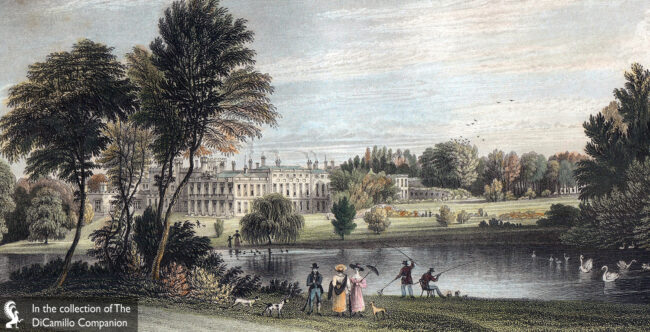
The house from an 1832 hand-colored engraving
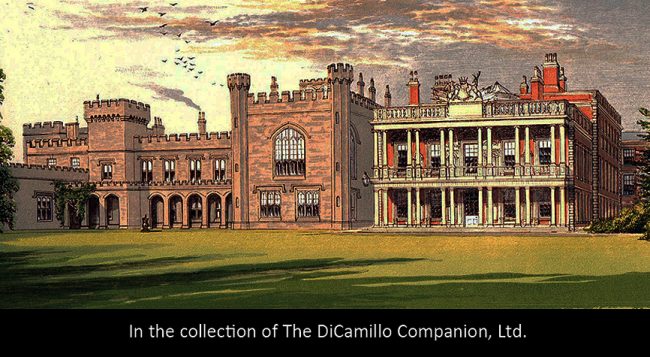
The south facade from "Morris's Views of Seats," circa 1875.
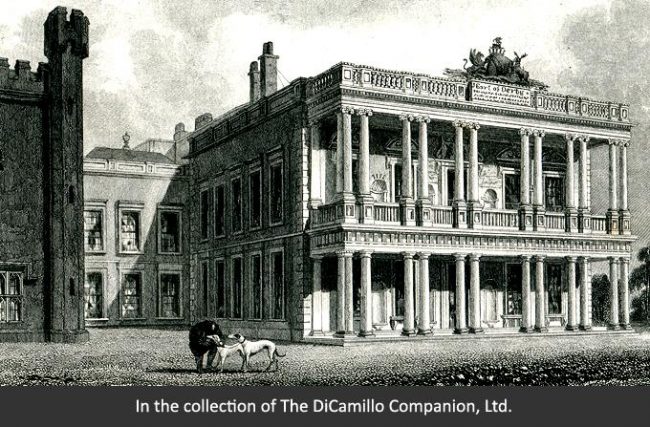
The south facade from an 1829 engraving by Fisher & Son, London.
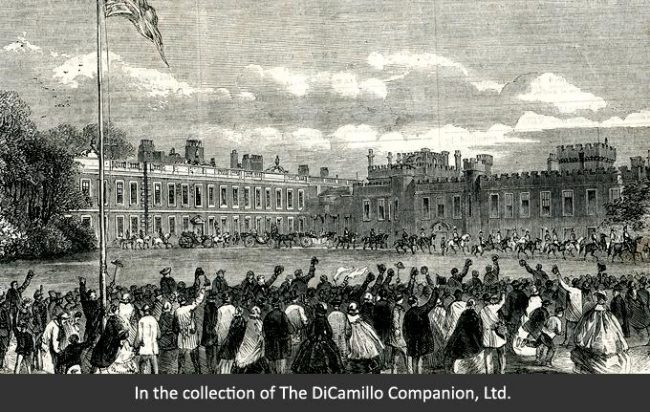
An 1860 wood-engraved print from "The Illustrated London News" entitled "The Review of Lancashire Rifle Volunteers in Knowsley Park The Earl and Countess of Derby leaving Knowsley Hall for the Review."
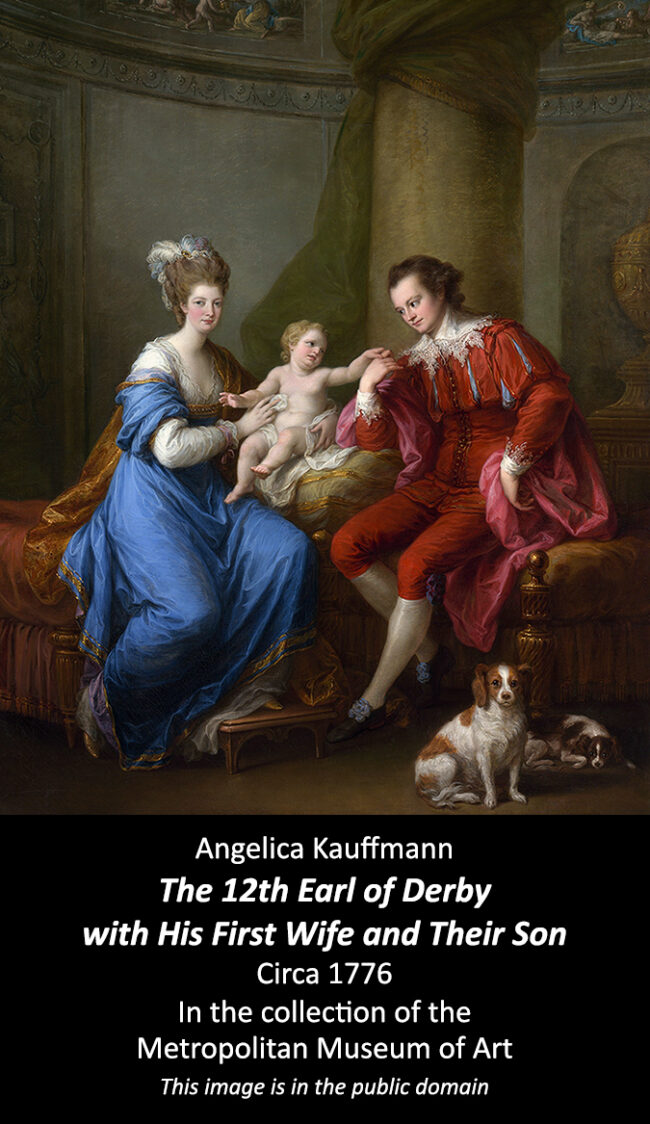
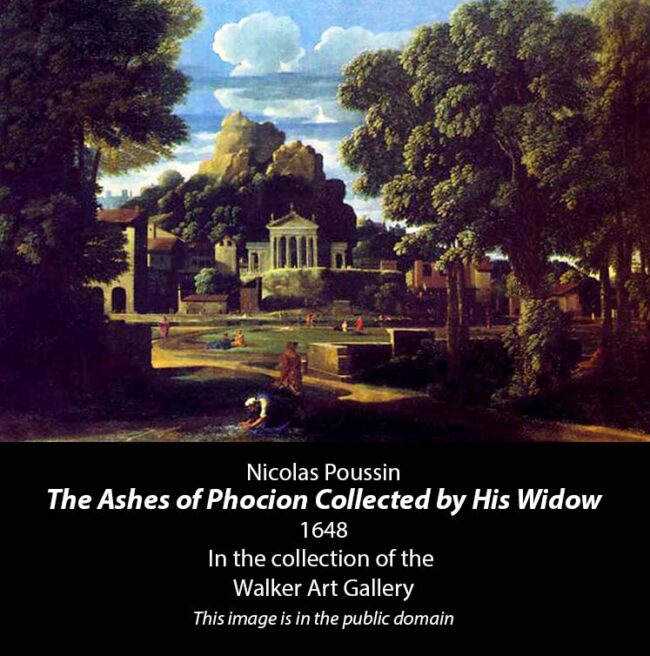
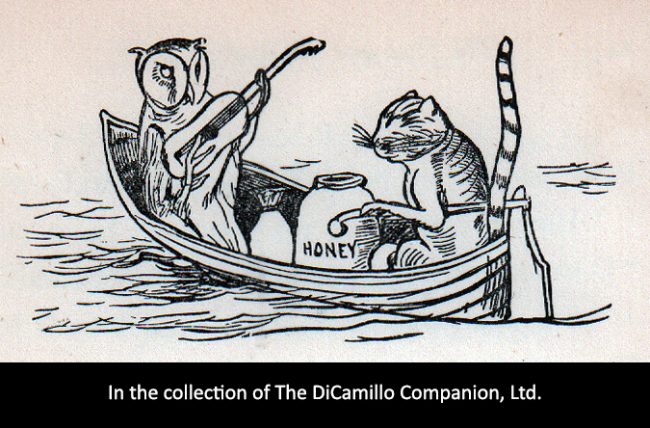
A 19th century illustration of the owl and the pussy-cat from Edward Lear's "Nonsense Songs, Stories, Botany, and Alphabets."
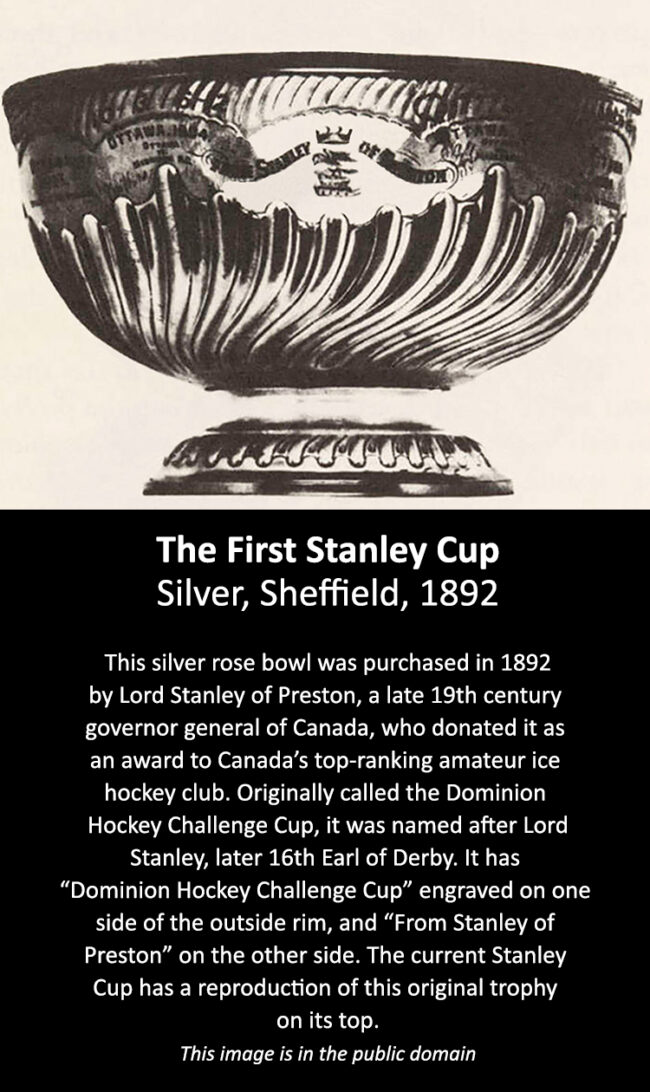
Earlier Houses: There has probably been a building on the site of the current house since the 12th century, including a Medieval hunting lodge, where the 1st Earl of Derby entertained Henry VII in 1495.
House & Family History: Many of the earls of Derby have been accomplished and productive members of society. The earldom was created in 1485 by Henry VII for Thomas Stanley, 2nd Baron Stanley, who helped ensure Henry became king at the Battle of Bosworth Field. The 5th Earl, who only reigned for a year before mysteriously dying in 1594 (possibly from poisonous mushrooms that many believe was part of a plot by the Jesuits), was a poet and patron of writers, including William Shakespeare. The 12th Earl (see “Images” section) was great fan of the turf (his racing colors were black with a white cap) and kept a menagerie at Knowsley that contained 94 different species of mammals and 318 species of birds. His influence on horse racing was huge: he founded the Oaks and the Derby, the former in 1778, after a dinner party at his Surrey estate, The Oaks (the first running was the next year and Lord Derby’s horse, Bridget, won the race). The Derby Stakes, also known as the Epsom Derby or the Derby, was founded by the earl in 1780 and remains the most prestigious of the five British Classics (Group 1 horse races run during the traditional flat racing season). But the 12th Earl was not only devoted to sports and animals; he also created the grand state dining room for the visit of George IV in 1821. The 14th Earl was a Victorian politician who served as prime minister three times and was responsible for steering the Slavery Abolition Act and the Second Reform Bill through Parliament. His political career was neatly summed up by Disraeli: “He abolished slavery, he educated Ireland, he reformed parliament.” The 13th Earl of Derby was a natural historian who was deeply interested in the animal and plant world and even had a bird, the Derbyan parakeet (Psittacula derbiana), named after him. Lord Derby formed an important and extensive natural history collection at Knowsley that is today housed in Liverpool’s World Museum. He was also president of the London Zoo, which was where, in the 1830s, he spotted Edward Lear painting watercolors of the animals. Lord Derby was so impressed that he invited the artist, author, and poet to come to Knowsley and paint the animals and birds in his great menagerie and aviary. Lear ended up staying for almost six years and created countless images of the animals and the landscape of the estate (hundreds of these paintings and drawings remain today in the collection at Knowsley Hall). It was during this time that Lear wrote the first version of “The Owl and the Pussy-Cat” (see “Images” section) to entertain Lord Derby’s grandchildren. This nonsense poem was later published in 1871’s "Nonsense Songs, Stories, Botany, and Alphabets,” which popularized the form and genre of literary nonsense. Lear’s connections to Knowsley Hall were celebrated throughout 2022 with a sculpture trail that featured 16 pairs of six-foot-high owl and pussycat statues placed throughout the park. The project was part of the celebration of the Knowsley borough as the 2022 Liverpool City Region Borough of Culture. On June 11, 1888, the 16th Earl of Derby, when Lord Stanley of Preston, was appointed by Queen Victoria as governor general of Canada. Lord Stanley and his family enthusiastically took to their huge new country: they traveled widely, appreciated the great outdoors, and met many “ordinary” people of Canada. In particular, Lord Stanley and his children became passionate ice hockey fans (the sons played), which led Lord Stanley to organize the playing of the sport in Canada. In 1892 Lord Stanley donated a silver rose bowl (see “Images” section) as the trophy to Canada’s top ranked amateur ice hockey club. Originally called the Dominion Hockey Challenge Cup, it was later renamed after Lord Stanley and has “Dominion Hockey Challenge Cup” engraved on one side of the outside rim and “From Stanley of Preston” on the other side. The current Stanley Cup has a reproduction of Lord Stanley’s original trophy on its top. Since 1926, only teams of the National Hockey League have competed for the honor, the oldest existing trophy to be awarded to a professional sports franchise in North America. Lord Stanley was inducted into the Canadian Hockey Hall of Fame in 1945. In 1960 an eight-foot-tall bronze statue of Lord Stanley welcoming the people of Canada to Stanley Park in Vancouver was unveiled. On the plinth are inscribed the words Lord Stanley uttered on October 29, 1889, when he dedicated the park: “To the use and enjoyment of people of all colours and creeds and customs for all time, I name thee Stanley Park.” In a famous incident at Knowsley in 1952, a mentally unstable footman shot at Lady Derby (wife of the 18th Earl) while she was at dinner; in the ensuing struggle the butler, the under-butler, the chef, and the valet were injured. In the 1950s two Victorian wings that contained five libraries and a billiard room were demolished by the 18th Earl who, in 1966, leased Knowsley Hall to the local police for offices (he moved into New House, a smaller house he built in in the 1960s in the park, where the family continue to live today). Before the 20th century demolitions, which reduced the house's size by 50%, Knowsley was one of the five largest houses in England. In the late 20th century the house was taken back by the family and re-opened to visitors and as a venue for conferences, weddings, and product launches.
Collections: Knowsley Hall houses the Derby Collection, one of the great private aristocratic art collections in Britain. The collection includes Old Master paintings, family portraits, furniture, ceramics, horseracing silver, and natural history watercolors, including those by Edward Lear. In 1954 Christie’s conducted a sale of the library at Knowsley, during which many important books were auctioned, including the 1465 Mainz edition of Cicero. Much of the library and archives once housed at Knowsley can be found today in the Lancashire Archives, the University of Liverpool, and the Archives of the Liverpool Central Library. Nicolas Poussin's "The Ashes of Phocion Collected by His Widow" (see "Images" section) was sold to the Walker Art Gallery, Liverpool, at Christie's in 1983 for more than £1 million.
Garden & Outbuildings: The Knowsley Estate spans 12,000 acres; the house is set in 2,500 acres of parkland landscaped in the 1770s by Capability Brown. Surrounded by a 10-mile-long wall, the park includes 100 acres of gardens and the Safari Park. The largest in Britain, the Safari Park was founded in 1971 by the 18th Earl of Derby and contains 30 species of mammals, plus birds, reptiles, and invertebrates, all roaming over 1,620 acres. The Safari Park had precedent; the 12th Earl of Derby kept a private menagerie at Knowsley in the 18th century. Between the 15th and the 18th centuries the Stanley family were lords of the Isle of Man.
Architect: Claud Phillimore
Date: 1950s and 60sArchitect: William Henry Romaine-Walker
Date: 1920sArchitect: John Foster
Date: 1822Architect: Robert Adam
Date: 18th centuryArchitect: William Burn
Date: 19th centuryArchitect: Joseph John Scoles
Date: 1820John Bernard (J.B.) Burke, published under the title of A Visitation of the Seats and Arms of the Noblemen and Gentlemen of Great Britain and Ireland, among other titles: Vol. II, p. 113, 1853.
John Preston (J.P.) Neale, published under the title of Views of the Seats of Noblemen and Gentlemen in England, Wales, Scotland, and Ireland, among other titles: 2.S. Vol. I, 1824.
Country Life: XXXIV, 54, 1913. LXXXI, 276, 1937.
Title: National Geographic (magazine)
Author: NA
Year Published: NA
Reference: Nov 1985, pg. 692
Publisher: Washington, DC: National Geographic Society
ISBN: 00279358
Book Type: Magazine
Title: Debrett's Peerage and Baronetage, 1990
Author: Kidd, Charles; Williamson, David (Editors)
Year Published: 1990
Reference: pg. P 351
Publisher: London: Debrett's Peerage Limited (New York: St. Martin's Press, Inc.)
ISBN: 0312046405
Book Type: Hardback
Title: Biographical Dictionary of British Architects, 1600-1840, A - SOFTBACK
Author: Colvin, Howard
Year Published: 1995
Publisher: New Haven: Yale University Press
ISBN: 0300072074
Book Type: Softback
Title: Disintegration of a Heritage: Country Houses and their Collections, 1979-1992, The
Author: Sayer, Michael
Year Published: 1993
Publisher: Norfolk: Michael Russell (Publishing)
ISBN: 0859551970
Book Type: Hardback
House Listed: Grade II*
Park Listed: Grade II
Current Seat / Home of: Edward Richard William Stanley, 19th Earl of Derby; Stanley family here since 1385.
Past Seat / Home of: SEATED AT EARLIER HOUSES: de Lathom family, 12th century until 1385. Sir John de Stanley, 1385-1414; Sir John Stanley, 1414-37; Sir Thomas Stanley, 1st Baron Stanley, 1437-59; Thomas Stanley, 2nd Baron Stanley and 1st Earl of Derby, 1459-1504. SEATED AT CURRENT HOUSE: Thomas Stanley, 2nd Earl of Derby, 1504-21; Edward Stanley, 3rd Earl of Derby, 1521-72; Henry Stanley, 4th Earl of Derby, 1572-93; Ferdinando Stanley, 5th Earl of Derby, 1593-94; William Stanley, 6th Earl of Derby, 1594-1642; James Stanley, 7th Earl of Derby, 1642-51; Charles Stanley, 8th Earl of Derby, 1651-72; William Richard George Stanley, 9th Earl of Derby, 1672-1702; James Stanley, 10th Earl of Derby, 1702-36; Edward Stanley, 11th Earl of Derby, 1736-76; Edward Smith-Stanley, 12th Earl of Derby, 1776-1834; Edward Smith-Stanley, 13th Earl of Derby, 1834-51; Edward Geoffrey Smith-Stanley, 14th Earl of Derby, 1851-69; Edward Henry Stanley, 15th Earl of Derby, 1869-93; Frederick Arthur Stanley, 16th Earl of Derby, 1893-1908; Edward George Villiers Stanley, 17th Earl of Derby, 1908-48; Edward John Stanley, 18th Earl of Derby, 1948-94.
Current Ownership Type: Individual / Family Trust
Primary Current Ownership Use: Private Home
Ownership Details: The house can be booked for weddings, events, and private stays.
House Open to Public: By Appointment
Phone: 01514-894-827
Fax: 01514-805-580
Email: [email protected]
Website: https://knowsley.com/
Awards: VisitEngland 2008 Gold Five-Star award for accommodation
Historic Houses Member: Yes